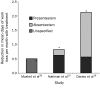The impact of migraine and the effect of migraine treatment on workplace productivity in the United States and suggestions for future research
- PMID: 19411440
- PMCID: PMC2676126
- DOI: 10.1016/S0025-6196(11)60562-4
The impact of migraine and the effect of migraine treatment on workplace productivity in the United States and suggestions for future research
Abstract
Evidence suggests that migraine is associated with decreased productivity. This article describes the results of a systematic literature review of peer-reviewed publications that measured the impact of migraine on workplace productivity in the United States and provides recommendations for future research. A MEDLINE search was conducted from January 1, 1990 to July 31, 2008. Articles were included if the results were from a prospective or retrospective study that reported work-specific productivity outcomes in adults with migraine in the United States. Twenty-six studies were included. Nine studies found that diagnosed and/or undiagnosed migraine had a negative impact on worker productivity. Although one migraine prophylactic study found a statistically significant improvement in worker productivity for topiramate-treated patients, another found an insignificant difference in lisinopril-treated patients. Fifteen studies compared the impact of triptan therapy with a control group. The control groups in these studies differed with regard to recall periods, time to follow-up, and types of questionnaires used. Almost all studies found that triptan therapy was associated with a statistically significant improvement in loss in worker productivity vs the control group. Health care professionals can reduce the impact of migraine on worker productivity with appropriate therapy. Researchers should collect presenteeism and absenteeism data, report results in units of time, use a validated instrument, carefully consider recall periods, and report worker productivity separately. In addition, patients with undiagnosed migraine should be included in disease burden studies. When evaluating effects of treatment on productivity, researchers should target well-controlled, double-blind studies and conduct productivity research for new treatments.
Figures


Comment in
-
The future of migraine: beyond just another pill.Mayo Clin Proc. 2009 May;84(5):397-9. doi: 10.1016/S0025-6196(11)60556-9. Mayo Clin Proc. 2009. PMID: 19411434 Free PMC article. No abstract available.
References
-
- Lipton RB, Scher AI, Kolodner K, Liberman J, Steiner TJ, Stewart WF. Migraine in the United States: epidemiology and patterns of health care use. Neurology 2002;58(6):885-894 - PubMed
-
- Hu XH, Markson LE, Lipton RB, Stewart WF, Berger ML. Burden of migraine in the United States: disability and economic costs. Arch Intern Med. 1999;159(8):813-818 - PubMed
-
- Osterhaus JT, Townsend RJ, Gandek B, Ware JE., Jr Measuring the functional status and well-being of patients with migraine headache. Headache 1994;34(6):337-343 - PubMed
-
- Stewart WF, Ricci JA, Chee E, Morganstein D. Lost productive work time costs from health conditions in the United States: results from the American Productivity Audit. J Occup Environ Med. 2003;45(12):1234-1246 - PubMed
-
- Stang PE, Osterhaus JT. Impact of migraine in the United States: data from the National Health Interview Survey. Headache 1993;33(1):29-35 - PubMed
Publication types
MeSH terms
LinkOut - more resources
Full Text Sources
Medical

